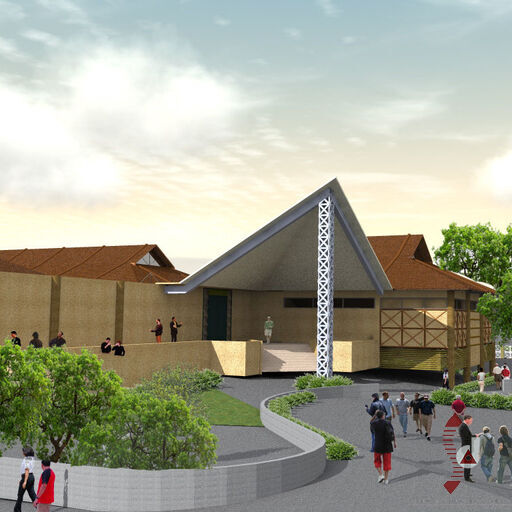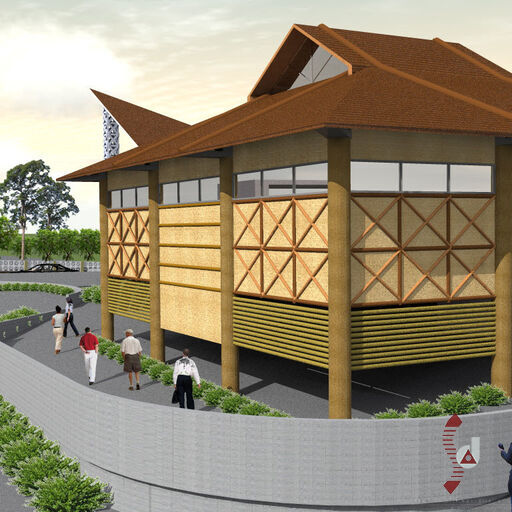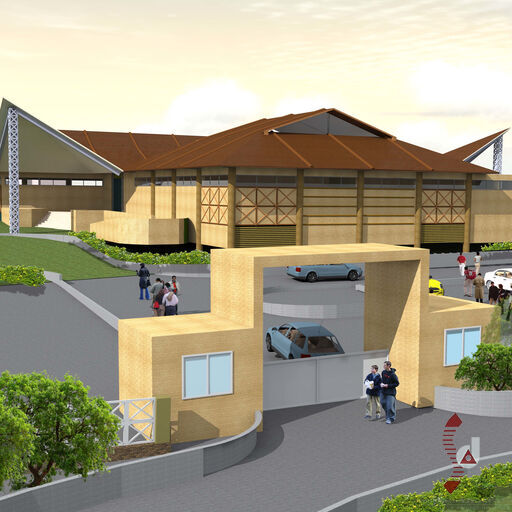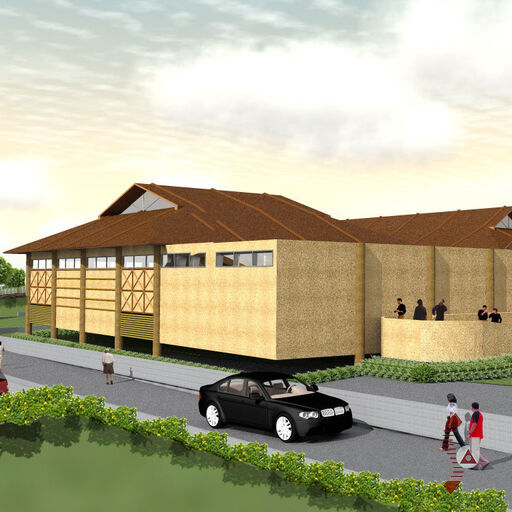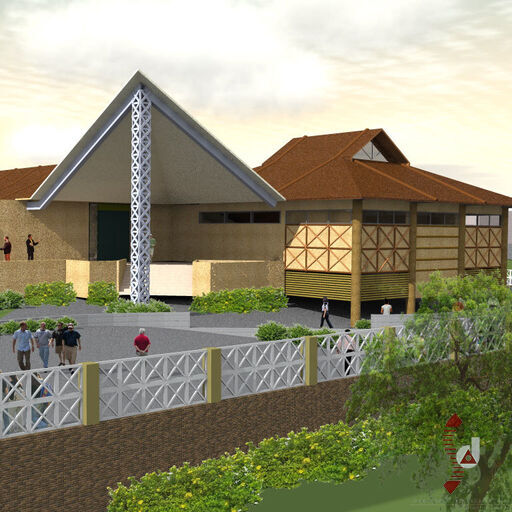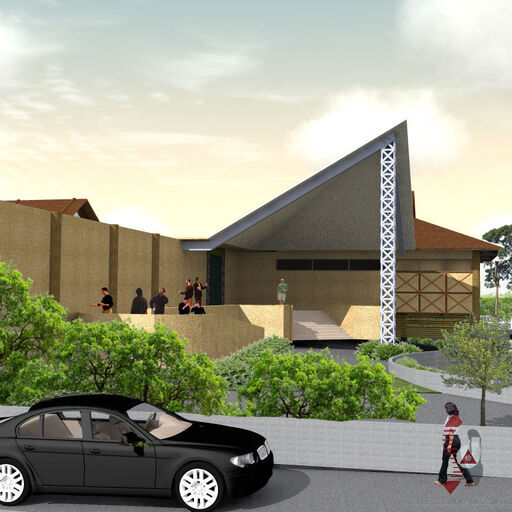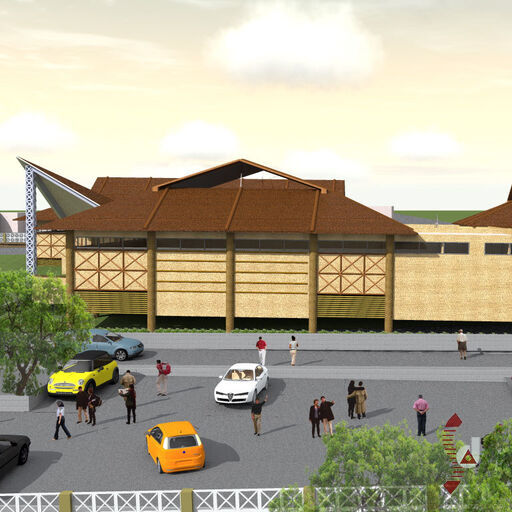SRSC Kokrajhar is Institutional architectural project designed by SDAARCHITECT, located in Kokrajhar, Assam.
Project Info
| Client |
National Council of Science Museums |
|---|---|
| Project Type |
Institutional |
| State |
Assam |
| City | Kokrajhar |
| Team |
Sunando Dasgupta Divya |
| Status | Design Proposal |
| Scale | Medium-Scale Projects |
Architectural Renders
Site Analysis
Location and Context
The proposed site for the Sub Regional Science Center is situated in the Bodofa Cultural Complex in Chandamari, Kokrajhar, Assam. The site covers an area of 4 acres and is strategically positioned adjacent to a major cultural hub, enhancing its accessibility and visibility.
Located along a major arterial road, the site links Kokrajhar town to Chandamari. This road provides essential access to the center and is a critical factor in the overall site planning.
The proposed site is generally flat with a gradual slope towards the Gaurang river, which flows north-south along the eastern edge of the property. It is important to note that the area is subject to flooding during monsoon seasons, highlighting the need for careful planning and design considerations.
Surrounding the site is dense vegetation typical of the high rainfall areas in Assam, contributing to the natural beauty and ecological diversity of the location.
Site Morphology
To address the potential risk of flooding, the building will be constructed on a raised plinth. This design choice is a traditional construction technique used by the Bodos, aimed at preventing floodwaters from entering the center.
Several major factors influence the site planning and building design of the proposed Sub Regional Science Center. These include:
- The proximity to the Gaurang river and the access road.
- The existing Bodofa Cultural Complex, which adds cultural significance to the site.
- The vernacular traditional construction style adopted by the local community.
- The functional requirements of the science center, integrated with the aforementioned parameters.
The Gaurang river, a tributary of the Brahmaputra arising from the Himalayas, experiences heavy flooding during the monsoon season. Therefore, the proposed building has been strategically located on the western end of the plot, as far as possible from the river and on the higher side of the property.
The main approach road runs in an east-west direction, directly connecting with Kokrajhar town. This elevated road provides a view of the proposed Science Center for passing vehicles, enhancing visibility and accessibility.
The design also considers the existing Bodofa Cultural Center, ensuring that the line of sight for motorists coming from Kokrajhar is not obstructed by the imposing structure of the Science Center. The goal is for both prominent buildings to complement each other, despite their differences in architectural character and scale.
Design Concept
The design concept for the Sub Regional Science Center is centered around creating an activity-based learning environment that encourages inquiry, fosters creativity, and cultivates a scientific temper within the community. The architecture aims to facilitate interaction and engagement through a dual channel of communication: exhibits and activities.
The Science Center will feature a variety of facilities, including hands-on exhibit-oriented exhibition galleries—both indoor and outdoor—activity areas, an exhibit development laboratory, an auditorium for lectures and demonstrations, innovation spaces, offices, and visitor interpretation areas. This multifaceted approach is designed to appeal to individuals of all ages, ensuring that learning is both fun and informative.
The center is planned to accommodate an average of about 500 visitors per day, with the capacity to handle up to 2000 visitors during peak holiday times. The overall built area will encompass approximately 1500 square meters, complemented by an outdoor Science Exhibit Park.
The design philosophy emphasizes sustainability and resilience, especially in light of the site's susceptibility to flooding. A raised plinth has been incorporated into the design to mitigate flood risks, reflecting traditional construction techniques practiced by the local Bodo community.
The overall architecture aims to harmonize with the surrounding environment, maintaining a balance between modern functionality and cultural relevance. The materials chosen for the construction, such as brick masonry with rough cast plaster and bamboo slat fenestration, will evoke local vernacular architecture while providing durability and aesthetic appeal.
The layout of the center is designed to create a seamless flow between spaces, promoting accessibility and encouraging exploration. The strategic placement of exhibits and activity areas within the center will foster interaction among visitors, making the learning experience more dynamic and engaging.
Site Layout
The site layout for the Sub Regional Science Center is meticulously designed to create a harmonious integration of built and natural environments. The overall design aims to foster an engaging learning atmosphere while ensuring functionality and accessibility for all visitors.
The center will be developed over a 4.0-acre plot, with a total built-up area of approximately 1500 square meters. The layout strategically positions various functional areas to promote seamless movement and interaction among visitors.
Key components of the site layout include:
Main Exhibition Center:
This area includes the reception, entrance foyer, and two large exhibition halls that will host interactive exhibits.
Visitor Activity Center:
Featuring a separate entrance foyer, a 100-seat auditorium, a children’s activity center, and a conference room. This zone is designed to facilitate diverse educational activities and events.
Service Area:
This section houses the office, exhibit development laboratory, and a loading/unloading area to support operational needs.
Outdoor Science Park:
This area is dedicated to outdoor exhibits and activities, providing an engaging space for visitors to explore science in a natural setting.
Picnic Areas:
Designed for relaxation and informal gatherings, these spaces will enhance the overall visitor experience.
Medicinal/Herbal Garden:
An educational garden that highlights the importance of local flora and its uses, fostering a deeper understanding of biodiversity.
Entrance Gate and Parking:
A well-defined entrance will facilitate visitor access, complemented by adequate parking facilities to accommodate visitors.
The layout thoughtfully incorporates green spaces, pathways, and seating areas to create a welcoming environment. A landscaped court in the center of the building will provide a natural gathering space, enhancing the overall aesthetic and functionality of the center.
Additionally, provisions for future expansion have been made within the layout to ensure that the center can adapt to the evolving needs of the community. By strategically locating the main building along the southern and western ends of the plot, ample space has been allocated on the eastern side for the development of the science park and its associated pathways.
Functional Layout
The functional layout of the Sub Regional Science Center is designed to ensure optimal use of space while facilitating a diverse range of activities and programs. The layout emphasizes accessibility, interaction, and educational engagement, catering to visitors of all ages.
The center encompasses several key functional areas, which are outlined as follows:
Main Exhibition Center:
The Main Exhibition Center comprises two large exhibition halls—Hall 1 and Hall 2—with net carpet areas of 350 sqm and 260 sqm, respectively. This area is designed to host interactive exhibits that engage visitors and encourage exploration of scientific concepts. The reception area and duty office are strategically positioned to facilitate visitor interaction and assist with inquiries.
Visitor Activity Center:
This center features a dedicated Children’s Activity Hall, allowing younger visitors to engage in hands-on learning experiences. Additionally, the 100-seat auditorium is designed for lectures and demonstrations, providing an environment for educational programs. The conference room, accommodating 10 to 12 persons, is equipped with audio-visual facilities to support meetings and workshops.
Service Area:
The Service Area includes an office for staff operations, an exhibit development laboratory for creating and maintaining exhibits, and a loading/unloading area to facilitate the movement of materials. This section is designed to support the efficient functioning of the center and ensure that operational needs are met.
Accessibility Features:
The functional layout prioritizes accessibility for all visitors. Ramps are provided at both entrances to ensure that individuals with disabilities can navigate the space with ease. The design includes clear pathways and signage to guide visitors through the center.
Exhibition Flow:
The layout promotes a logical flow from one functional area to another, encouraging visitors to explore various exhibits and activities seamlessly. The central landscaped court provides a natural gathering space and serves as a visual focal point, enhancing the overall visitor experience.
Movement and Circulation
The design of the Sub Regional Science Center places a strong emphasis on movement and circulation to enhance the visitor experience. The layout is thoughtfully structured to facilitate smooth transitions between different functional areas while ensuring accessibility for all.
Key aspects of movement and circulation within the center include:
Entrance and Access:
The main entrance is strategically located to welcome visitors and provide easy access to the center. The entrance features a spacious foyer that serves as a gathering point, allowing visitors to orient themselves before exploring the exhibits and activities. The design ensures that the entrance is easily identifiable and accessible from the parking area.
Circulation Paths:
The circulation paths within the center are designed to be intuitive and unobstructed, guiding visitors through various zones. A 10-meter wide ambulatory connects the Main Exhibition Center and the Visitor Activity Center, facilitating easy movement between the two areas. Landscaped courts and pathways enhance the overall aesthetic while providing clear routes for visitors.
Accessibility Considerations:
Accessibility is a paramount consideration in the design of circulation spaces. Ramps are integrated at both entrances to accommodate individuals with disabilities, ensuring that all visitors can navigate the center comfortably. Additionally, clear signage is provided throughout the facility to assist visitors in locating key areas and services.
Flow of Movement:
The layout promotes a natural flow of movement, encouraging visitors to explore various exhibits without confusion. The arrangement of exhibition halls, activity centers, and service areas is designed to create an engaging experience, allowing visitors to move seamlessly from one area to another.
Visitor Engagement:
Strategic placement of exhibits and interactive installations encourages visitors to engage with their surroundings. Open sightlines and well-defined pathways allow for easy interaction with exhibits while fostering a sense of curiosity and exploration.
